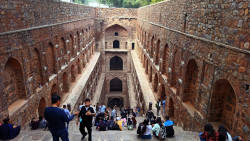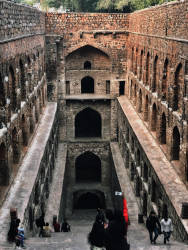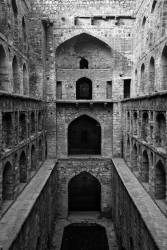अग्रसेन की बावली
Agrasen ki Baoli - Ugrasen ki Baodi - Akshay Ki Baoli - Oojer Saini Bowlee
Useful Information


| Location: |
Hailey Road, KG Marg, near Diwanchand Imaging Centre, New Delhi, Delhi 110001.
Nearest Metro Stations: Mandi House (Blue Line), Janpath (Yellow Line), Barakhamba Road or Rajiv Chowk. (28.625851, 77.225049) |
| Open: |
All year daily 9-17:30. [2023] |
| Fee: |
free. [2023] |
| Classification: |
 Stepwell Stepwell
|
| Light: | n/a |
| Dimension: | L=60 m, W=15 m, VR= m, St=103. |
| Guided tours: | self guided |
| Photography: | allowed |
| Accessibility: | no |
| Bibliography: | |
| Address: |
Agrasen ki Baoli, Hailey Road, KG Marg, near Diwanchand Imaging Centre, New Delhi, Delhi 110001.
Delhi Tourism, 18-A, D.D.A.SCO Complex, Defence Colony, New Delhi-24, Tel: +91-11-23365358, Tel: +91-11-23363607. E-mail: |
| As far as we know this information was accurate when it was published (see years in brackets), but may have changed since then. Please check rates and details directly with the companies in question if you need more recent info. |
|
History
| 14th century | built during the Tughlaq or Lodi period of the Delhi Sultanate. |
| 2012 | the government started issuing tickets for Agrasen Ki Baoli. |
Description



अग्रसेन की बावली (Agrasen ki Baoli, Agrasen Stepwell) is designated a Historic Monument by the Archaeological Survey of India (ASI). Like with many other stepwells, its age and origin is unknown, the most popular theory is that it was originally built by the legendary Raja Agrasen, hence the name. He lived in somewhat esoteric or mystic times, the age of the Mahabharata, and he was one of the descendants of the Hindu deity Kusha, Shri Ramchandra’s elder son. He established a kingdom of traders in North India named Agroha. It is actually unknown if and when he lived, so this origin of the stairwell is completely mystic. Its current state, on the other hand, is a result of a massive restauration during the Tughlaq or Lodi period of the Delhi Sultanate in the 14th century. Evil tongues claim that this was in fact the time of creation, but one should be careful, there is nothing more fanatical than true believers.
The rectangular ditch extends almost north-south. It is entered from the southern end down a long staircase. The walls show fake facades and pillars, which have three levels. The staircase has either 103 or 108 steps, it seems to be quite difficult to count them. One webpage actually wrote, "The monument boasts of 103-108 steep steps".
Ugrasen ki Baoli was built out of rubble masonry, using an assortment of rocks and stones. The niches on the sides on three levels partly lead to small rooms or arched niches, which were used for various religious functions and ceremonies. But the site was also a community place. When it was till in use, women used to assemble in the well, the cooler temperatur inside provided them with a perfect spot to avoid the scorching heat outside.
Located close to the studios, this site was used as a filming location for various Bollywood movies. The list includes PK (2014) starring Aamir Khan, Sultan (2016) starring Salman Khan, Mon (2017) starring Sridevi, and the second episode of The Amazing Race Australia 2 (2012). We actually never heard of those films, most of them only have a Hindi-language version and never made it outside India.
According to an urban legend, the site is haunted. It is considered the most haunted place in Delhi by some. When you descend into the well, the sound totally vanishes and only the echo of our own footsteps remains. In this weird acoustic situation, some visitors feel a strong eerie presence. The screeching of bats and noises of pigeons add to its mystery. The water in the well is black and bottomless and is said to call out to people and convince them to sacrifice their lives by jumping into the water. The bodies of those vanished and were never found. Some people assert that the Baoli is a residence of Devils. Others say it is haunted by the ghosts of those who were lured into the black water. Fortunately, it is closed during the night, and the well actually dried out some years ago.
There are more than 30 baolis in Delhi, but most are ruins. As far as we know, there are three more which are worth a visit. Unlike this one, they are not rectangular but circular. The baolis were used as cisterns, to store rainwater. The fact that the Agrasen Stepwell is now dry is obviously because the responsible Archaeological Survey of India (ASI) decided not to let rainwater flow into the stepwell. Probably they found the remaining water too stinky. The oldest existing baoli of Delhi is Anangtal near Mehrauli, built in the 10th century during the reign of the Tomar dynasty.
 Search DuckDuckGo for "Agrasen ki Baoli Stepwell"
Search DuckDuckGo for "Agrasen ki Baoli Stepwell" Google Earth Placemark
Google Earth Placemark OpenStreetMap
OpenStreetMap Agrasen Ki Baoli - Wikipedia (visited: 02-DEC-2023)
Agrasen Ki Baoli - Wikipedia (visited: 02-DEC-2023) Agrasen ki Baoli, official website (visited: 02-DEC-2023)
Agrasen ki Baoli, official website (visited: 02-DEC-2023) Index
Index Topics
Topics Hierarchical
Hierarchical Countries
Countries Maps
Maps